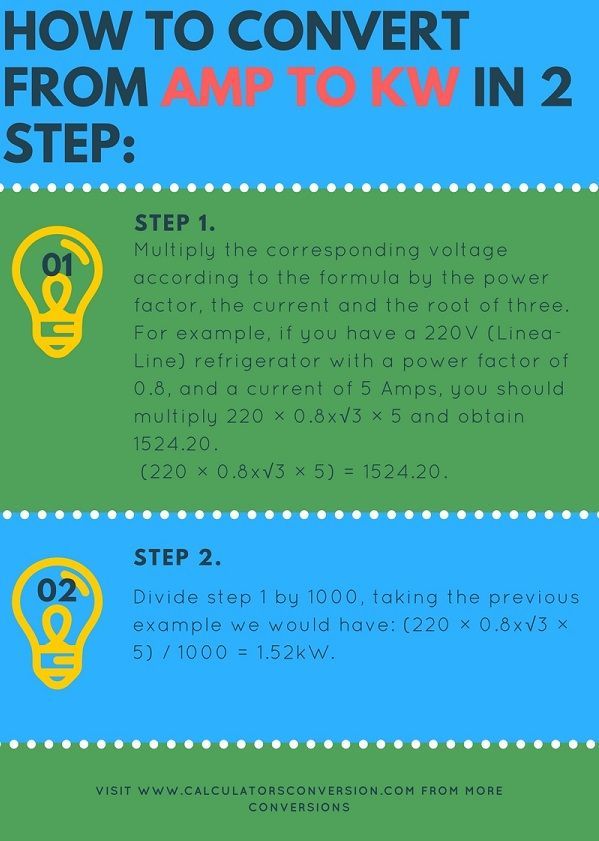
#KW TO AMP FORMULA FOR 3 PHASE FULL#
This completes 1 full cycle for that line. As the negative pole starts to come closer, the current reverses and moves in the other direction towards another peak before returning to zero current. Then as the positive pole spins past that wire, the current starts to weaken until the magnet is perpendicular again which results in zero current. As the magnet moves, you can see the current go to its peak. Which means the magnet is perpendicular to that line. If you look at the waveform example you can see the first line in blue, and it starts at zero. Now let’s explain those confusing waveforms that are frequently used to depict 3 phases. 12 and 6 positions are Line 1's alternating peaks, 2 and 8 positions are Line 3’s alternating peaks, and 4 and 10 are Line 2’s alternating peaks. At 6 different positions on the clock face, one of the lines is at peak. Only 1 of the 3 lines is ever at peak, but because there are 3 lines, there are 3 peak positive and 3 peak negative positions for every cycle. It is at zero current when the north pole points to 3 and 9 o’clock. It's at its peak current when the north pole points to both 12 and 6 o’clock positions. As the magnet goes around the clock face, each of the 3 lines will be affected by either the north or south poles, except when the magnet is perpendicular to a line. It also shows the relationship between the 3 lines as the magnet spins in a circle. Hopefully, this example shows you how at any time current is always flowing in at least 2 lines. At 3 o’clock, the magnet is perpendicular to Line 1 so electrons stop moving, but Line 2 is affected by the north pole and line 3 is affected by the south pole so the current is flowing in lines 2 and 3. When the magnet’s north pole faces 2 o’clock, then Line 1 and 2 are affected by the north pole but the south pole is directly opposite Line 3 so it’s now at peak current. But they are still moving in line 1 attracted by the closer north pole and they are moving in line 3 repelled by the south pole. As the magnet is spinning, when the north pole is at 1 o’clock it becomes perpendicular to line 2 so of course, the electrons stop moving in line 2. In each three of these lines, as the electrons are moving back and forth, they are not always moving in the same direction or speed as the other two lines. The closer the south pole gets to each wire, the more the electrons move away from the south pole. If the north pole is closer to one of the 3 wires, then the electrons move in that direction. The 3 lines are equally spaced around the circle. And at the eight o’clock position is 120 degrees away from both the 4 and 12 o’clock positions. So when you're at the four o'clock position in our example here, that's 120 degrees away from line one. When generating 3 phase power, the copper lines are located 120 degrees apart. Going from 12 to 3 is 90 degrees and going from 12 to 4 is 120 degrees. A circle is 360 degrees and the clock divides the circle into 12 sections so that each hour covers 30 degrees of the circle. Looking at the chart, you can see why I picked an analog clock face. If you clicked on this video without a thorough understanding of alternating current, please view that video first. That was described in detail in the alternating current video. Then as the magnet swings, more than 90 degrees and the south pole of the magnet comes closer to line one, and the electrons will reverse which means the direction of the current will reverse. What happens when the magnet now swings 90 degrees?Īs we saw in the alternating current video, because the magnet is perpendicular to line 1, the electrons in line one will stop moving. The electrons in line 1 are going to be flowing towards the north pole of the magnet. To help explain the concept easier, let's use a clock face and say that line one is at the twelve o'clock position. In this three-phase example, the north positive end of the magnet is pointing straight up at line one.

Now we’re going to spin a magnet past 3 wires and see the effect that has on the current in each wire. In the alternating current video, we showed how spinning a magnet past one wire caused the current to flow back and forth.

This example is different from what I would use to describe how a three-phase motor uses power. Let’s look at a simplified example of how 3 phase power is generated. The power that enters a data center is usually 3 phase AC power, which means 3 phase alternating current power. I’ll also explain the mystery behind why the 3 power lines are 120 degrees apart because that’s a crucial piece to understanding 3 phase power. Welcome to this animated video that will quickly explain 3 phase power.


 0 kommentar(er)
0 kommentar(er)
